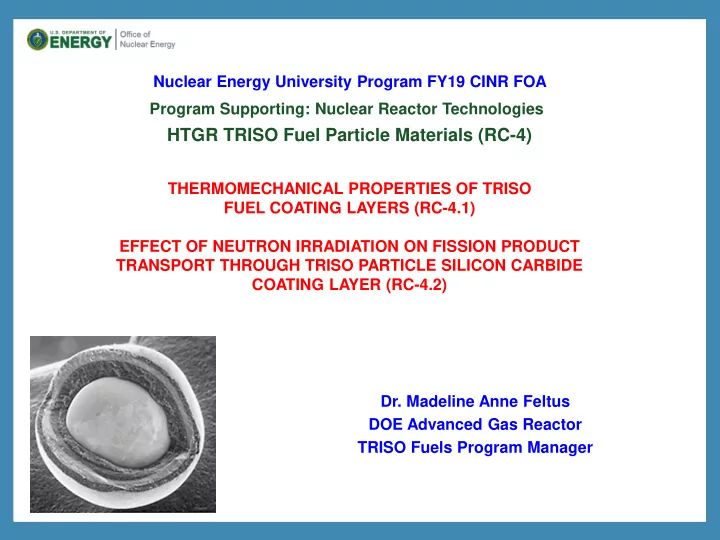

Nuclear Energy University Program FY19 CINR FOA Program Supporting: Nuclear Reactor Technologies HTGR TRISO Fuel Particle Materials (RC-4) THERMOMECHANICAL PROPERTIES OF TRISO FUEL COATING LAYERS (RC-4.1) EFFECT OF NEUTRON IRRADIATION ON FISSION PRODUCT TRANSPORT THROUGH TRISO PARTICLE SILICON CARBIDE COATING LAYER (RC-4.2) Dr. Madeline Anne Feltus DOE Advanced Gas Reactor TRISO Fuels Program Manager
HTGR TRISO Fuel Particle Materials (RC-4) THERMOMECHANICAL PROPERTIES OF TRISO FUEL COATING LAYERS (RC-4.1) Motivation for research: • Experimental data is needed to model TRISO fuel performance in simulation codes, e.g., PARFUME. • Inner PyC coating mechanical failure exposes the inner SiC surface to fission product attack, primarily Pd. • Focus on most sensitive properties as a function of neutron irradiation, e.g., PyC irradiation-induced creep, dimensional changes, elastic modulus, tensile strength. • Buffer properties and bond strength with IPyC layer (irradiated, un-irradiated) are needed, as well as new measurement Eligible to Lead: Universities Only techniques. Maximum funding $800,000 Duration: Up to 3 years
HTGR TRISO Fuel Particle Materials (RC-4) EFFECT OF NEUTRON IRRADIATION ON FISSION PRODUCT TRANSPORT THROUGH TRISO PARTICLE SILICON CARBIDE COATING LAYER (RC-4.2) Motivation for this research: • Limited work on effects of neutron irradiation-induced polymorphism in SiC • Intra-granular fission product (FP) precipitation has not been well-explained by any known nucleation mechanism. • FP nucleation in TRISO SiC occurs in a two step mechanism: Cubic (β ) hexagonal (α) SiC polymorphic transition 1. Subsequent transition of (α) SiC into fission product precipitates 2. • Potential mitigation of FP precipitate damage effects in TRISO SiC layer, primarily Pd, during high temperature conditions, up to 1600 °C. Proposals using advanced microscopy (e.g., TEM, HRTEM) and experimental methods on un-irradiated and irradiated TRISO SiC at different dpa are requested. Eligible to Lead: Universities Only Maximum funding $800,000 Duration: Up to 3 years
HTGR TRISO Fuel Particle Materials (RC-4) Proposals MUST: Focus on obtaining experimental data for parameters • that have greater impact on TRISO particle fuel failure predictions (see: Collin, Skerjanc, INL/EXT-18-44631). Use the most prototypic neutron-irradiated TRISO • Irradiated buffer, SiC, and/or PyC materials or un-irradiated buffer TRISO materials available from the AGR TRISO program. Emphasize carefully designed experiments that provide • new measurements for materials properties and/or characterize newly-observed phenomena for TRISO PIEs. Produce useful results for TRISO fuel performance code • models, input and validation. Proposals MUST NOT focus on developing new computational models (e.g., ab initio or MCNP studies). Proposals MAY develop new correlations based on performing property measurements, microscopy, any new separate effects tests, or irradiation experiments.
HTGR TRISO Fuel Particle Materials (RC-4) Proposals should: • Consider the effect of neutron irradiation on TRISO SiC, IPyC, OPyC, buffer and kernel properties and use irradiated AGR TRISO specimens as available. • Focus on separate effects tests and experiments where results are used to develop prototypic correlations for possible use in existing TRISO fuel performance computer codes. • Material specimens used should be relevant to AGR TRISO irradiation campaign ranges: - Burnup 5% - 20 % fissions per initial metals atoms (FIMA) - Fast neutron fluence: 1.0 - 4.5 E25 n/m 2 (E > 0.18 MeV) - Irradiation temperature: 900 to 1250°C. • Use realistic ranges for HTGR temperatures, TRISO fuel temperatures, neutron damage rates, based on vendor design information.
HTGR TRISO Fuel Particle Materials (RC-4) Proposals must NOT repeat research or earlier tests performed by NEUP grants and the AGR TRISO Programs ** Previous SiC specimen layer irradiation damage using • proton acceleration (e.g., University of Michigan). Previous microscopy (SEM/TEM) studies done by the • AGR TRISO program team that have been published. Proposals may repeat some previous research to qualify new measurement techniques, and benchmark neutron irradiation damage if new specimens are made at the university. ** See INL Advanced Reactors Technology, AGR TRISO fuels, NGNP, NEUP websites at: https://art.inl.gov/default.aspx; https://neup.inl.gov
HTGR TRISO Fuel Particle Materials (RC-4) STEM at CAES Proposals may: Use in-situ university laboratories for surrogate, • non-radioactive specimens for TRISO buffer tests. Develop new measurement techniques and test rigs • that could possibly be used in glove boxes or hot cells for getting data from radioactive specimens. Use existing specimens from Advanced Gas Reactor (AGR) TRISO • fuel experiments at NSUF locations for hot-cell PIE, SEM, TEM, FIB microscopy, etc. Suggestions: Coordinate with AGR TRISO Fuel Program team to FIB at MFC • get appropriate irradiated, un-irradiated specimens. Partner with DOE lab staff for advice about hot cell • and glove box implementation issues. Contact HTGR fuel and reactor vendors about their • TRISO fuel, reactor system operations envelope accident scenario conditions.
HTGR TRISO Fuel Particle Materials (RC-4) Quality Assurance Compliance Quality Assurance and Data Retention: Data collection, experiments, data validation, and verification may • require compliance with NQA-1 2009 and 2009 NRC accepted paragraphs. Archiving data and simulation results in the INL Nuclear Data • Management and Analysis System (NDMAS) may be required Test Facility Data NDMAS Data SAS Acquisition Data Management and Systems Statistical Analysis SAS EBI Environment Information Display and Delivery Experimental Create Views, Archive Data Analyses
HTGR TRISO Fuel Particle Materials (RC-4) Interested university applicants may contact: • Federal POC: Dr. Madeline Feltus DOE, AGR TRISO Program Manager madeline.feltus@nuclear.energy.gov • Technical POC: Dr. Paul Demkowicz INL, AGR TRISO Technical Manager paul.demkowicz@inl.gov
Recommend
More recommend